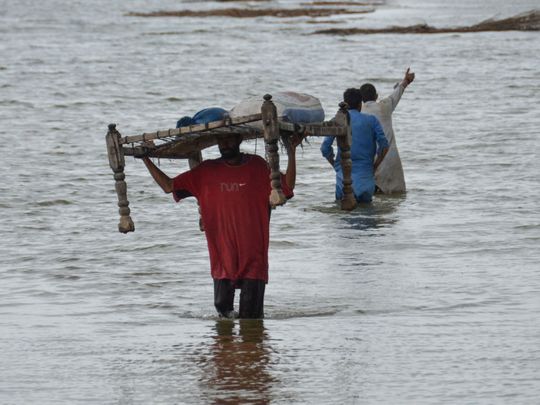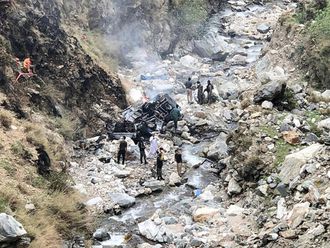
KARACHI: Pakistan has urged the international community to help with relief efforts as it struggles to cope with the aftermath of torrential rains that triggered massive floods last month, killing more than 800 people, officials said.
Funding and reconstruction efforts will be a challenge for cash-strapped Pakistan, which is having to cut spending to ensure the International Monetary Fund approves the release of much-needed bailout money.
July’s national rainfall was almost 200% above average, Sardar Sarfaraz, a senior official at the metrological office told Reuters on Wednesday, making it the wettest July since 1961.
“No question of the provinces or Islamabad being able to cope with this magnitude of climate catastrophe on their own.
Lives are at risk, thousands homeless. Int’l partners need to mobilise assistance,” said Sherry Rehman, Federal Minister for Climate Change in a tweet.
According to the United Nations Office for Coordination of Humanitarian Affairs (OCHA), heavy monsoon rainfall and floods have affected some 2.3 million people in Pakistan since mid-June, destroying at least 95,350 houses and damaging a further 224,100.
Sindh in the country’s south east and Balochistan in the south west are the two most affected provinces. More than 504,000 livestock have been killed, nearly all of them in Balochistan, while damage to nearly 3,000 km of roads and 129 bridges has impeded movement around flood-affected areas.
Climate catastrophe of epic scale
The main supply route from the port city of Karachi has been cut for more than a week after a bridge linking it to Balochistan was swept away, while dozens of small dams in the province were overwhelmed.
Federal government has also appealed to the international development partners for assistance, so reconstruction of infrastructure destroyed by the flooding can be started once the water recedes” Ahsan Iqbal, Minister of Planning, Development and Special Initiatives said in a twitter post.
In Sindh, the government closed all educational institutions in anticipation of fresh rain forecast for Wednesday and Thursday and an airport in the Nawabshah district remains closed with the airfield almost fully submerged.
“It is a climate catastrophe of epic scale, bringing in its wake the humanitarian crisis that could well match the magnitude of the big flood that was witnessed in 2010” said Rehman.
The annual monsoon is essential for irrigating crops and replenishing lakes and dams across the Indian subcontinent, but each year it also brings a wave of destruction.
Heavy rain continued to pound much of Pakistan Wednesday, with authorities reporting more than a dozen deaths - including nine children - in the last 24 hours.
Heatwave
“It has been raining for a month now. There is nothing left,” a woman named Khanzadi told AFP in badly hit Jaffarabad, Balochistan province.
“We had only one goat, that too drowned in the flood... Now we have nothing with us and we are lying along the road and facing hunger.”
Earlier this year much of the nation was in the grip of a heatwave, with temperatures hitting 51 degrees Celsius (124 Fahrenheit) in Jacobabad, Sindh province.
The city is now grappling with floods that have inundated homes and swept away roads and bridges.
In Sukkur, about 75 kilometres (50 miles) away, volunteers were using boats along the flooded streets of the city to distribute food and fresh water to people trapped in their homes.
Zaheer Ahmad Babar, a senior met office official, told AFP that this year’s rains were the heaviest since 2010, when over 2,000 people died and more than two million were displaced by monsoon floods that covered nearly a fifth of the country.
Rainfall in Balochistan province was 430 per cent higher than normal, he said, while Sindh was nearing 500 per cent.
The town of Padidan in Sindh had received over a metre (39 inches) of rain since August 1, he added.
The National Disaster Management Authority said in a statement that nearly 125,000 homes had been destroyed and 288,000 more were damaged by the floods.
Some 700,000 livestock in Sindh and Balochistan had been killed, and nearly two million acres of farmland destroyed, officials added.
Nearly 3,000 kilometres of roads had also been damaged.













